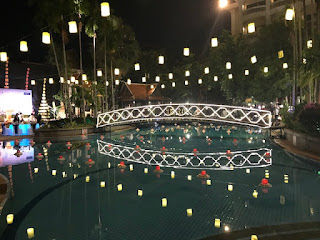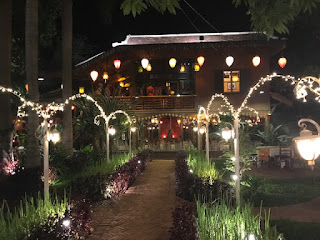This is our first trip to this part of south east Asia. We are with our good friends Clive and Rosie and we fly into Hanoi. There is great poverty in Vietnam. I know this because I can see some of it through the windows of the air-conditioned coach that meets us with the Riviera travel guide on arrival. We are doing this trip in style in 5 star hotels and this makes me feel guilty. Will I get a true taste of Vietnam if the only locals I meet are the ones carrying our bags to our hotel room?
The trip into Hanoi is hair-raising. There are 85 million people in Vietnam and 21 million motorbikes, all of them honking furiously. Life is lived on a moped. I see one piled high with chickens in hutches. On another, two men are balancing a six-foot pane of glass. Entire families travel on one scooter, Mum clutching the baby while Dad steers. No one pays attention to road markings, and crossing the street is like a game of Frogger. Our guide says you should just walk confidently across the road and hope the mopeds weave around you. I don't like this idea and wait for a break in the traffic. Phil pulls me by the hand and we manage to cross!!!
We are on a whirlwind tour of Vietnam and Cambodia. We want to see as much as possible in two weeks, so Riviera, the tour company, has organised a sort of travel taster-menu of the two countries. There is so much to cram in that we're barely off the plane, holding on to our hats for a cyclo rickshaw ride round the Old Quarter. Buzzing with noise and activity the narrow alleys are packed with hundreds of small shops, a street for shoes, one for Christmas decorations, another for dresses and home goods. Scooters, everybody selling something, street food, crazy woven electrical wires, small plastic chairs, a wonderful assault on the senses! I love to see everyday life on the streets of wherever I travel and there is so much to see, and taste and listen to on the streets of Hanoi's old quarter.
Hanoi is a crazy polluted city and our hotel, The Melia, provides a welcome escape from the madness outside. Rosie and I go for a refreshing swim whilst Phil and Clive visit Hoa Lo Prison Museum, once known to American PoWs as the "Hanoi Hilton".
We meet up later for a drink in our room. A can of beer costs 30p!!!! Then out to dinner.
The guidebooks say you can eat safely and cheaply from the many street kitchens. These are basic, open-fronted shops where an old lady cooks on a simple stove on the pavement whilst the customers sit on small plastic garden furniture. There's no menu; each street kitchen serves either pho (noodle soup) or bun cha (char-grilled pork served with noodles and a green salad). I'm worried the salad might be washed in tap water, which will kill me so we decide to eat at Phieu Tinh Tien, a restaurant recommended by Alex our guide. The food was delicious and we ask for the bill - the teenage waitress charges us 1,050,000 Vietnamese dong. This seems an awful lot though it's actually only £25 - we pay up.
The next morning we have a guided tour of the Temple of Literature - Vietnam's first university. A beautiful 2000 year old complex that was used to train Vietnam's greatest scholars, poets and politicians in ancient history. It's both a beautiful historical relic and a relaxed and shady walk through a garden oasis in the middle of Hanoi. WHAT......A...GEM!! So much culture, history and beauty! Hands down my favourite site in Hanoi.
We then continued to Ho Chi Minh's Mausoleum. Ho Chi Minh's embalmed body is on display in a timber/glass casket in this building. The amount of security we had to go through was amazing. Hundreds of people line up to get into here, but the line was constantly moving over the 15 minute walk. Guards everywhere and four at all times around his body. They file you in pairs of two and you are not allowed to stop. Such a surreal experience looking at this man under a soft light looking peaceful. The severe stone blocks of the Mausoleum are in stark contrast to the nearby Stilt House that was Ho's home for over a decade.
Sunday afternoon was free for us to explore the city. So after a delicious lunch at The Green Tangerine we visited the city park with a lake in the middle of it. We cross the attractive red-painted arched wooden bridge to the Jade Mountain Temple. The park is crowded with families and the children smile and want to practice their English.
Next we're at a traditional water puppet theatre (image a U-rated Punch and Judy show performed in a learners' pool).
From Hanoi, we take a one and a half coach journey to the coast, stopping off at a Pearl factory en route.
It's November 12th, our wedding anniversary and we are up early for our flight to Danang.
Danang's newest attraction is the spectacular Dragon Bridge, which spans the Han River. Not only is it illuminated with LED lighting at night, it also breathes fire and spouts water at intervals.
We take the old road over the Cloudy Pass to Hue. The road is pretty narrow and winding but it offers spectacular views. At the top there are war remnants of lookouts and gun towers. Danang is the city where US troops landed in Vietnam.
We also stopped to watch the train pass on its way from Danang to Hue. The journey is very scenic but rather slow, I gather. You can apparently choose a hard or soft seat.
Next we make our way down to Hue in the central provinces. It is one of the country's most beautiful small towns, bisected by the serene Perfume River. A charming, restful little town where we spend two nights at the Imperial Hotel. The French colonial style is scattered throughout Vietnam, evidence of the years of Gallic meddling in the region, and it's hard not to feel guilty as we rumble past corrugated iron shacks before being deposited in yet another gorgeous hotel dripping with imperial splendour. The hotel has an amazing rooftop bar with a stunning view over Huong river and the view towards the Imperial Citadel further.
We then walk into town and stumbled across the Rustic Kitchen and Chill Bar in the centre of town. The food was great value and the staff super friendly. Add to that the quirky décor and a swing seat and you have the perfect combination. We then stopped at the DMZ bar. An American GI themed bar. Good place to stop and watch the world go by. Seats are made of empty barrels/drums - all in a commando style. Returned the next night for dinner. An amazing wedding anniversary and Hue had laid on some decorations for us too.
The next morning we visit the absolutely incredible sprawling citadel with many different areas to get lost in, really amazing. Beautiful art and craftsmanship and intricate telling of Hue's story as the Imperial seat of Vietnam. Whenever I look at these magnificent structures I am in awe as to how they were constructed in a time when tools of trade must have been basic. One wonders as to the monumental task of hauling the blocks of stone to create such magnificent buildings. Within the complex is the Imperial City. Everything is painted in the royal colours of red and gold and the whole building is a stunning example of the magnificent lifestyle enjoyed by the Vietnamese royal family. Entrance to this royal city is via the imposing Ngo Mon Gate, beyond which a bridge leads between lotus-filled ponds to the splendid Thai Hoa Palace. Behind this is an open courtyard that overlooks a stretch of land, once home to the Forbidden Purple City.
Hien Lam Pavilion is also known as the Pavilion of Splendor. This exquisite triple-roofed temple is situated within the Yellow Enclosure of the Imperial City and presides over the massive Nine Dynastic Urns. Cast on the orders of Emperor Minh Mang, they weigh up to 2.75 tons each. Decorated with traditional patterns, and rich in symbolic detail, they play a big role in the cult of imperial ancestor veneration. You can also see the bullet holes from the recent troubles.
We then went on to the Thien Mu Pagoda set amidst verdant greenery, this is the oldest pagoda in Hue. Built in 1601, the 69 ft high tower is an official symbol of the city of Hue.
After a short Dragon boat ride on the Perfume River we stop for a sumptuous multi-course lunch of Imperial cuisine.
We then visited Emperor Tu Ducs mausoleum. Emperor Tu Duc of Vietnam held the longest reign of any monarch of the Nguyen dynasty, from 1848 to 1883. Over that time, he accumulated a great mass of wealth, yet he had no children to pass it down to (despite having 104 wives and an additional smattering of concubines). Since he had plenty of money at his disposal, he decided to have a large tomb and palace complex built according to his own design well before his death in 1883. The construction required forced labour and extra taxation, causing a coup plot to move against Tu Duc in 1866, but it was discovered and suppressed. The tomb went on to become the most impressive and popular of the royal mausoleums. Once the complex was complete, Tu Duc and his many wives utilized it as a residence and a scenic retreat. They would go boating on Luu Khiem Lake and Tu Duc hunted small game on the island within the lake. After boating, it was common for Tu Duc and his wives to relax in the nearby pavilion, where he would often compose or recite poetry. Tu Duc and those close to him worried that when he eventually died, looters would rob his tomb of gold and other valuables. So Tu Duc made arrangements before he passed. When the time came, 200 labourers carried the emperor's remains and his fortune to a secret location for burial. What the labourers didn't know was that they would all be beheaded upon their return to protect the secrecy of Tu Duc's final resting place. Our guide denied this happened and to this day, Tu Duc's supposed tomb has yet to be discovered. Which begs the question......where is Tu Duc actually buried and how much treasure lies with him?
On our way back to the hotel we stop at a small village which makes the conical hats and incense sticks.
Day 7 and we fly to Ho Chi Minh City, or Saigon as the locals still insist on calling it. Built virtually from scratch by the French, on a bend of the wide Saigon River. Did a city tour covering all the major sights including the colonial-style central post office, the Cathedral and the Reunification Palace where famously in 1975, a tank burst through its gates in the final defining moment of the Vietnam War.
To give you a little overview, the Vietnam War started in 1955 and went for 20 years until 1975 across Vietnam. It was crippling for the country on many levels, not least the Agent Orange chemicals that were sprayed across swathes of jungle to ensure nothing would ever grow there again, polluting the water and soil and killing the trees like Round Up. And we also know the devastating effects that had on the people of Vietnam (and also the allied forces) for generations afterwards. To get a harrowing insight into the war as a whole, Phil and Clive visited the War Remnants Museum. A sobering experience, but at the same time important to see it from a side we in the west have probably not seen before. The War Remnants Museum is located in the former US Information Service building, this exhibition was once known as the War Crimes Museum.
The Vietnam War was officially fought between the north and south Vietnamese governments, and the rest of the world got involved because the communists (supported by Russia and China) were seeking to take over the south like it did in Korea. The Viet Cong were a south Vietnamese communist front, also known as the National Liberation Front, and fought a guerrilla war against their southern brothers, while the People's Army of Vietnam (also known as the North Vietnamese Army) fought a more conventional war.
On a lighter note we stay at the excellent Equatorial Hotel. It's beginning to look a lot like Christmas.
There are various ways to learn about the Vietnam War and the following day a visit to the Cu Chi tunnels, a complex underground network stretching for 200 kilometres, certainly added another layer for me. It acted as a reminder of the desperation and bravery of the North Vietnamese as well as the horrible and frightening lives of the forces they were fighting. My naive preconceived ideas were of a deadly game of cat and mouse. The reality would have been of terror and misery - whether it was the bombing and being buried alive or death/serious wounding from the Viet Kong's booby traps. No wars are glorious - this was brutal reality.
In the evening we decided to visit the Hotel Majestic in town for cocktails on the 8th floor. The best rooftop view in Ho Chi Minh City. M bar is on the rooftop of the swanky Majestic Hotel on the banks of the river. I understand this is where a lot of journalists stayed during the Vietnam War. We took a seat on the balcony overlooking the river and all of the life on the streets below whilst sipping a cocktail or two.
Dinner was at the Lemon Grass Restaurant. The food was good, the restaurant seems to have retained its old world charm and the decor is quite a throwback. Enjoyed the local zither player too.
The next day we drive towards the great Mekong River delta. Stopping en route at Vinh Trang Temple. The temple itself is lovely with it's gates and large topiarised bonsai trees. But the Buddhas - WOW! There are three giant Buddhas, the Buddha of yesterday which is lying down, the Buddha to today which is at the gate, and the Buddha of tomorrow - commonly known as the happy Buddha - is smiling at the world.
We then board our boat across the Mokong to Coconut Island where we watch coconut candy being made. Delicious taste - not so sure about the snake wine though.
Next was a Sampan cruise on one of the tributaries of the Mekong. We stepped into our boat tentatively but started enjoying the ride almost as soon as our boat started making its way past lush palm trees and stunning green foliage. Day trips such as this are bound to feel 'touristy', but one look at the brightly-coloured boats bobbing along the calm waters of the Mekong made us fall in love with the river. It ended far too quickly.
We then walked through the jungle to a small village where we sat on a wobbly bench under a thatched roof as we sampled Vietnamese honey tea. Regular tea is flavoured with the juice of kumquats (a small citrusy fruit, similar to limes) and sweetened with home-made honey. Bee pollen might be the newest health fad to hit the western world, but here in the backwaters of Vietnam, it is generously spooned into every cup of tea. We sipped on the tea and munched on the accompanying fresh fruit.
Lunch is at a typical local restaurant for a meal of local Mekong specialities, including the famous and delicious deep-fried elephant ear fish!
Our last morning in Vietnam and we leave very early to board a tiny plane for Cambodia.
As we leave the aircraft, the heat wallops me in the face like a giant hot towel (There are lots of actual hot towels in Vietnam. People hand you hot towels constantly. In hotels, restaurants, everywhere. You will never want for a wet towel.) We stop at the National Museum, in a lovely setting in Phnom Penh's city centre. Lots of artefacts but they are mostly sculptures from Buddhist and Hindu religions and tend to be a bit similar unless you are a devotee.
Our hotel in Phnom Penh is the Royal Gate Hotel. An oasis of calm and regal service. Situated right next to the Royal Palace and close to the Mekon River. It is a tastefully modernised ex-French Colonial edifice with large comfortable rooms, a french colonial dining room, beautiful pool and we loved the roof-top bar overlooking the majestic Royal Palace.
Day 11 and we visit the majestic Royal Palace with its silver pagoda just across the road from our hotel. It was very hot so we returned to the hotel for a swim but Clive bravely went on to visit the Tuol Sleng Museum - originally a school, turned into the country's most notorious prison by the Khmer Rouge.
We then had an exciting tuk tuk ride to meet Clive and the rest of the tour group for lunch in a local restaurant.
As we sip cocktails and beers on the roof-top bar it is hard to imagine that in 1975 this entire city was evacuated and the population moved into enforced labour camps in the countryside. While Vietnam remains poor, it has had several decades to clear away the debris of war and build up a thriving tourist industry. In neighbouring Cambodia, violence and bloodshed stopped only in the past 10 years or so. Pol Pot's Khmer Rouge were still operating as a guerrilla movement well into the 1990s.
With the Rhmer Rouge now disbanded and a relatively stable government in place, the country has done an impressive job of plastering over the tragedy and unrest of its recent past. Phnom Penh is full of bustling street-cafes and tourists in rickshaws visiting the glittering royal palace. The people are charming and friendly but behind the facade the country's scars are still there. The Killing Fields are now gruesome tourist destinations and Toul Sleng prison is now a museum. According to Clive it's a chilling and deeply moving place with hundreds of haunting photographs of the victims hanging on the walls.
Another early morning flight. This time to Siem Reap where we stay 3 nights at the Borei Angkor Resort and Spa. We are all excited. Tomorrow we visit Angkor Wat.
Our delightful guide in Siem Reap, Pitt, cheerily tells us his extraordinary tale of life under the Khmer Rouge as a small child and it's as gripping as any Hollywood thriller. Bless him.
Shouldn't tell you this but the secret to getting Angkor Wat all to yourself is to enter at 8 a.m. via the East Gate, which is much smaller than the iconic West Gate, and the only other people we saw there when we first arrived were the water vendors there to set up their stands before potential customers come flooding in. We managed to climb to the top of the temple also without queuing. The temp was hitting 80 degrees and I'm glad I managed to cross it off my bucket list in such a relatively stress-free way.
Temple 2 - The Bayon: The Temple with Many Faces.
We crossed the bridge of many faces to this must see temple, famous for the huge 216 carved stone faces which jut out from 54 gothic towers. Built at the end of the 12th century as the only Buddist Shrine dedicated to Buddha. The faces can be seen staring down at you all around, sometimes it's awesome, other times is eerie: eyes are looking at you wherever you turn. The Bayon is nothing short of spectacular. The faces are a mixture of smiling and stony-faced (excuse the pun).
Temple 3 - Ta Phrom: The "Tomb Raider" Temple.
Ta Phrom was built in 1186 as a Buddhist Temple by King Jayavarman VII to honour his mother.
After the fall of the Khmer Empire in the 15th century, Ta Phrom was left abandoned. The jungle began to grow in and around some of the stones, and huge strangler fig tree roots swallowed them. Large moss covered stones and dilapidated towers lay in crumbled piles around the temple. When it was discovered, the jungle had reclaimed the ruins to such an extent, it was decided to leave it as it was. Ta Phrom is very atmospheric, I could easily let my imagination run away, and can see why it was chosen for a Tomb Raider movie. Walking over steps, from room to room through thick stone walls and down narrow corridors we navigated the best route, led by Pitt, across sandy uneven rocks. I couldn't help but feel a little like Lara Croft. Crumbled dilapidated stones lay scattered like huge Jenga blogs. Nature has reclaimed this building making it a mysteriously beautiful temple.
That evening, to finish off a fabulous day, Pitt organised for us to visit a local restaurant, Kanell. It was an outdoor oasis with a stage for five traditional cultural dance performances whilst enjoying a delicious Cambodian meal. A wonderful evening.
We then set off on a boat on Tonle Sap |Lake ("Great Freshwater Lake" in English) to see the life of the residents of the Mechrey Floating Village. Their lives are literally tied to the lake, with bamboo "racks" acting as mooring posts for their floating homes. Imagine living on a boat without tap water, electricity or anything you expect in a place called home. The residents are fishermen, providing much of the fish and seafood for not only Cambodia, but much of Asia. Tonle Sap is Southeast Asia's largest lake. Residents of the villages are both Cambodian and Vietnamese, although most of the residents are ethnically Vietnamese whose families have been on the Cambodian side of the lake for generations. There is an interesting history surrounding these Vietnamese who were deported from Cambodia during the Khmer Rouge reign, but returned after the fall of the Khmer Rouge to re-establish their homes and livelihood from fishing.
We also stopped off to see the crocodile farm.
The villagers move their houses based on the river level. Even though the living conditions are tough, you can still see smiles on people's faces. This makes me feel guilty again. I am peering at poor people like they're animals in a zoo. This is the agony of holidaying in developing countries. Some say you are bringing welcome cash into the economy, others that you are exploiting the impoverished locals. Have I seen the real Vietnam and Cambodia? I haven't ventured off the tourist trail, so not really, but if you're like me and you want to see far-flung places without getting your hands dirty, it can be done, and in great style and safety.
Such a wonderful holiday. Vietnam and Cambodia are packed with history, stunning landscapes, cultural highlights and amazing food. The people are so very friendly too. Visit soon before these beautiful countries are over-developed.
Our last night in Siem Reip. Our hotel and dinner at Madam Butterfly.
Thank you Clive and Rosie for your excellent company once again and for the gift which I shall treasure.
And a big thank you also to Alex our excellent Rivieria guide and to the local guides at each destination. Their knowledge was amazing.






















































































































































































No comments:
Post a Comment